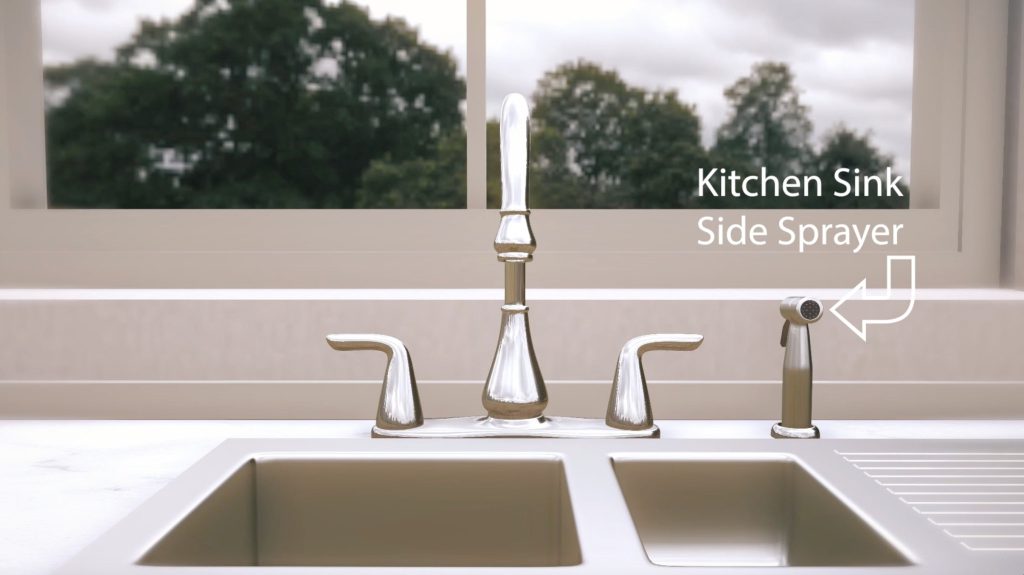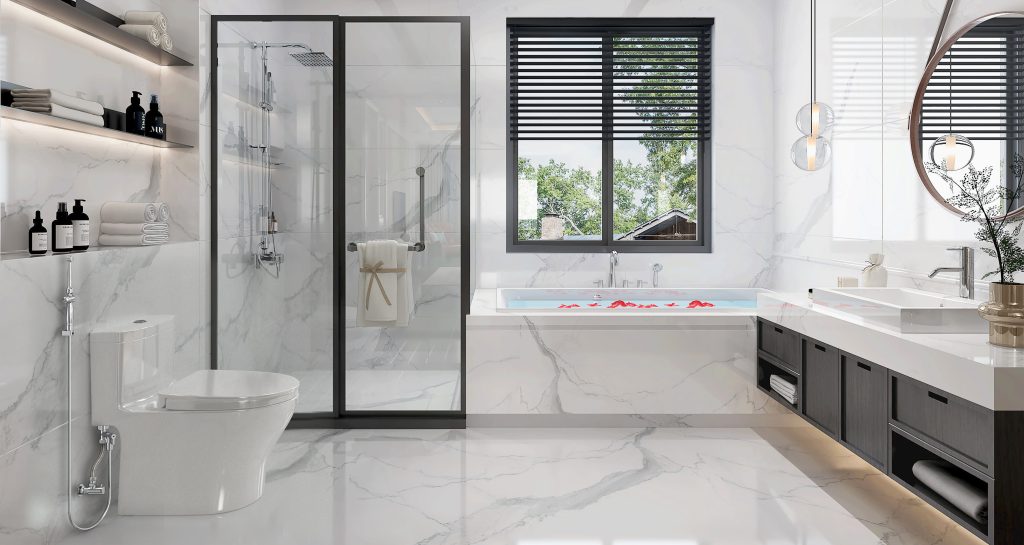
Introduction
In recent years, bidet converter kits have garnered significant popularity among individuals seeking a more comfortable and hygienic bathroom experience. These kits are an innovative alternative to conventional toilet paper use.
One of the key benefits of using a bidet converter kit is the ease of use and its compatibility with most standard toilets. They are also easy to install and require minimal maintenance, making them a practical and cost-effective upgrade. In addition to the convenience factor, bidet converter kits are more environmentally friendly as they reduce paper waste and prevent clogging of pipes.
However, choosing the right bidet converter kit for your bathroom can be daunting due to the wide range of options available. When making a purchase, it’s important to conside
r several factors.This article delves into more detail on the various aspects to consider when selecting a bidet converter kit, and provides valuable insights to help you make an informed decision.
What is a Bidet Converter Kit?
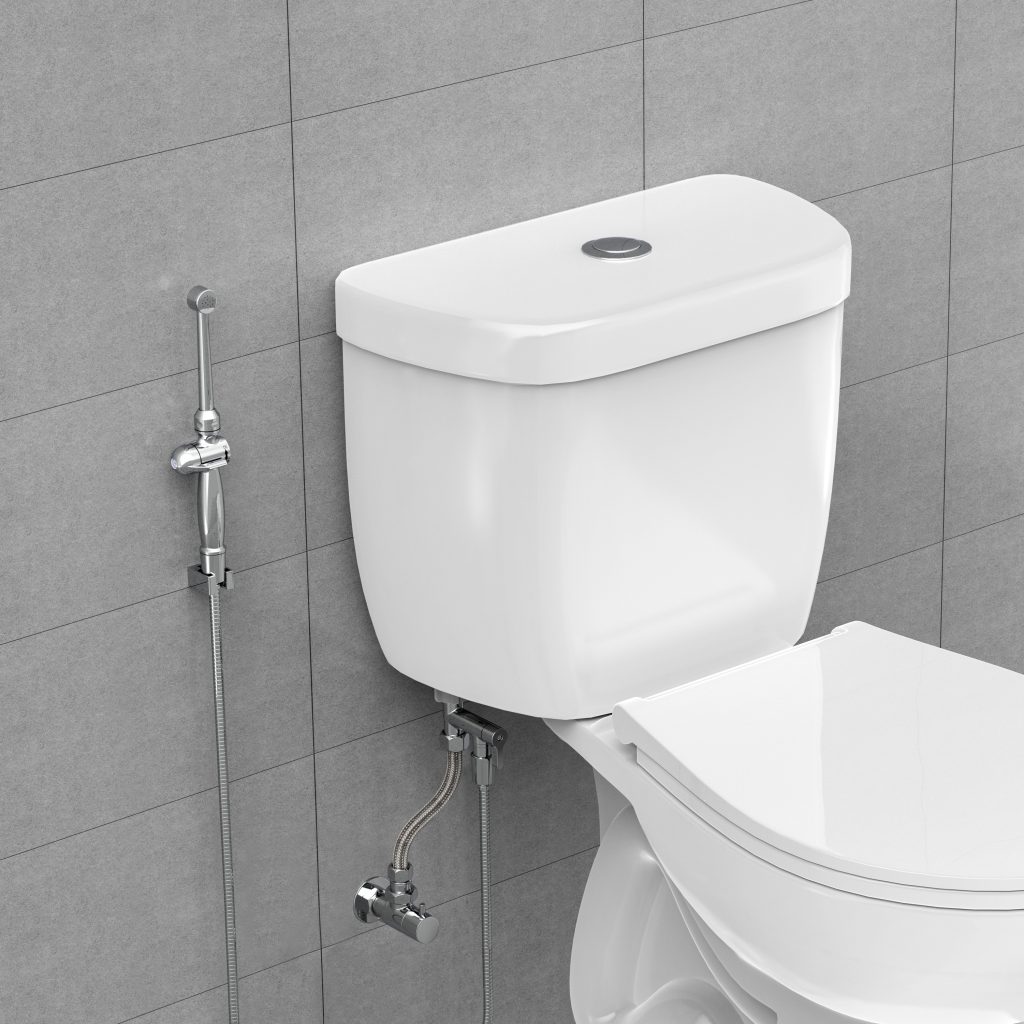
A bidet converter kit is a bathroom accessory that can be installed on an existing toilet to transform it into a bidet. It typically consists of a sprayer or nozzle attached to the toilet’s water supply, allowing for convenient cleansing after using the toilet.
The Aquaus 360 Bidet Converter Kit represents a groundbreaking advance in personal hygiene, providing a superior alternative to outdated bathroom routines. Its innovative design is redefining the way we think about cleanliness and comfort in our daily lives. Designed with precision and comfort in mind, this handheld bidet outperforms other options such as kitchen sink sprayers and seat-attached bidets. With its unique features, durability, and legal installation, the Aquaus 360 ensures a refreshing and efficient bathroom experience. In this article, we will explore the limitations of other bidet options, highlight the exceptional features of the Aquaus 360, compare it to alternative bidet systems, and explain why it is the optimal choice for your bathroom.
Benefits of a Bidet Converter Kit
Improved Hygiene
One of the key advantages of bidet converter kits is the enhanced hygiene they offer. Traditional toilet paper may leave residue or irritate sensitive skin, while bidet sprayers provide a thorough and gentle cleanse, reducing the risk of infections or irritation.
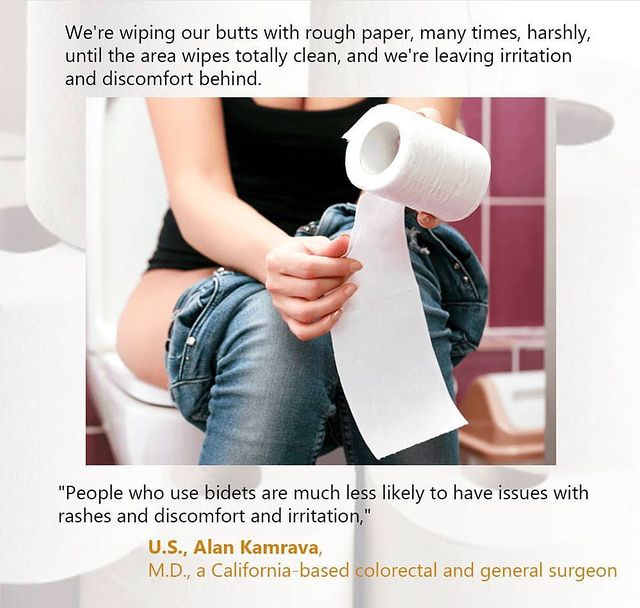
Cost-Effective Solution
Bidet converter kits offer a cost-effective alternative to full bidet installations. They are more practical than standalone bidets and require minimal plumbing modifications. Additionally, bidet converter kits reduce the need for excessive toilet paper usage, leading to long-term cost savings. The average person spends over 90 dollars a year for toilet paper. A family of 4 can use over 350 dollars a year. Using a Bidet and rinsing with fresh running water reduces toilet paper use by 90%.
In an era where sustainability is paramount, bidet converter kits stand out as an eco-friendly choice. By minimizing toilet paper consumption, bidet sprayers contribute to reducing deforestation and the environmental impact associated with paper production.
Did you know that the U.S. alone uses 36 billion rolls of toilet paper every year? That’s equivalent to 15 million trees, 100 billion gallons of water, 250,000 tons of chlorine, and 17 terawatts of electricity. These numbers are shocking, and it’s time for us to take responsibility for our impact on the environment. So, let’s make some changes!

Enhanced Comfort
Using a bidet converter kit can provide a luxurious and comfortable experience. Some bidet kits offer full adjustable water pressure control and precision rinsing that allows users to customize the cleansing process to their preference.

Factors to Consider when Choosing a Bidet Converter Kit
Installation Method
Bidet converter kits can be categorized into two main installation types: handheld and toilet seat-mounted. Handheld options offer more flexibility, allowing the user to direct the water spray manually. Toilet seat-mounted bidets provide a more permanent fixture, with the sprayer integrated into the toilet seat that only sprays from the back.
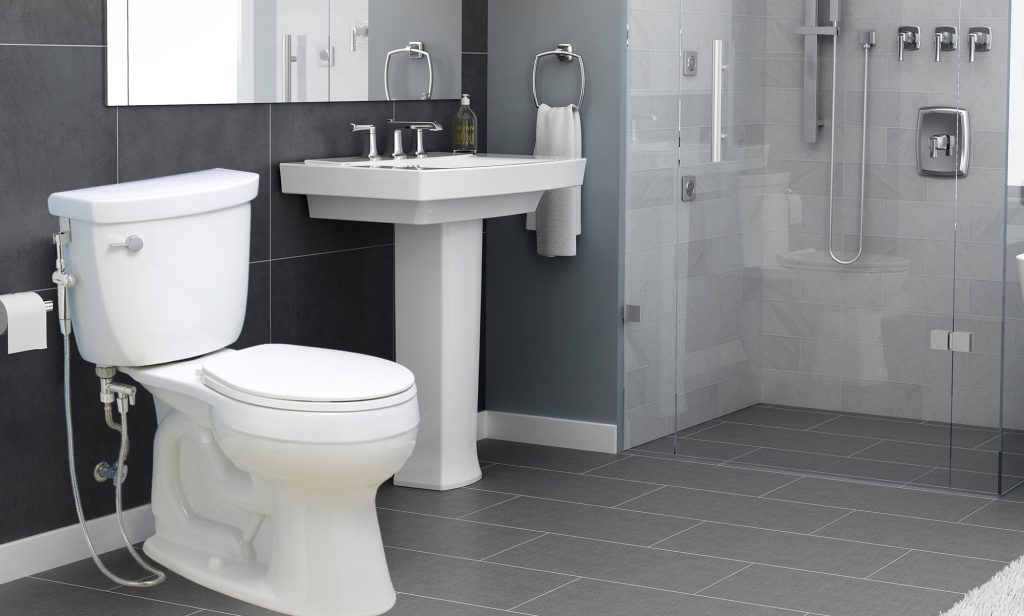
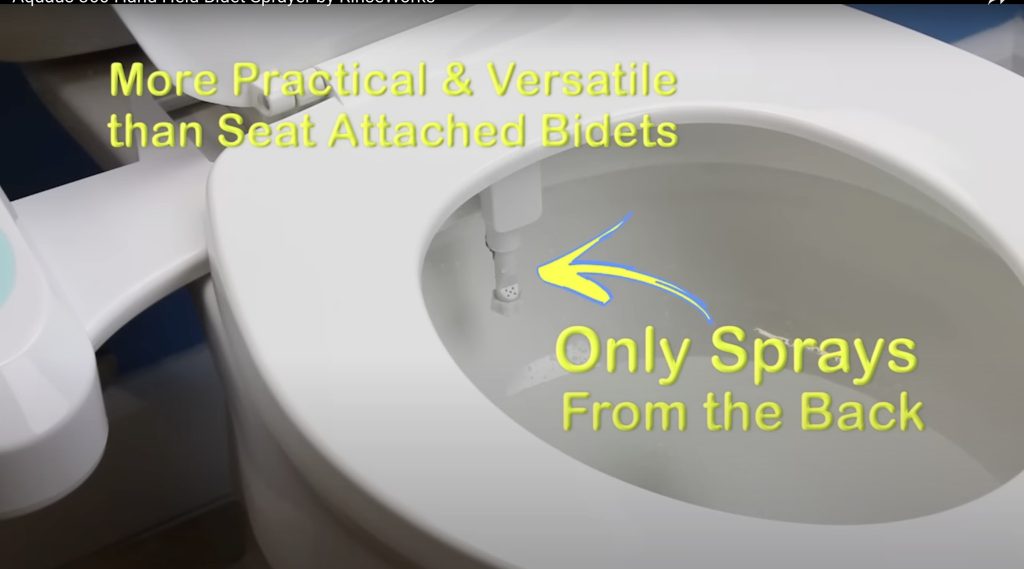
Adjustable Features
Consider the availability of adjustable features like water pressure control, and interchangeable spray patterns. These options allow users to personalize their bidet experience according to their preferences.
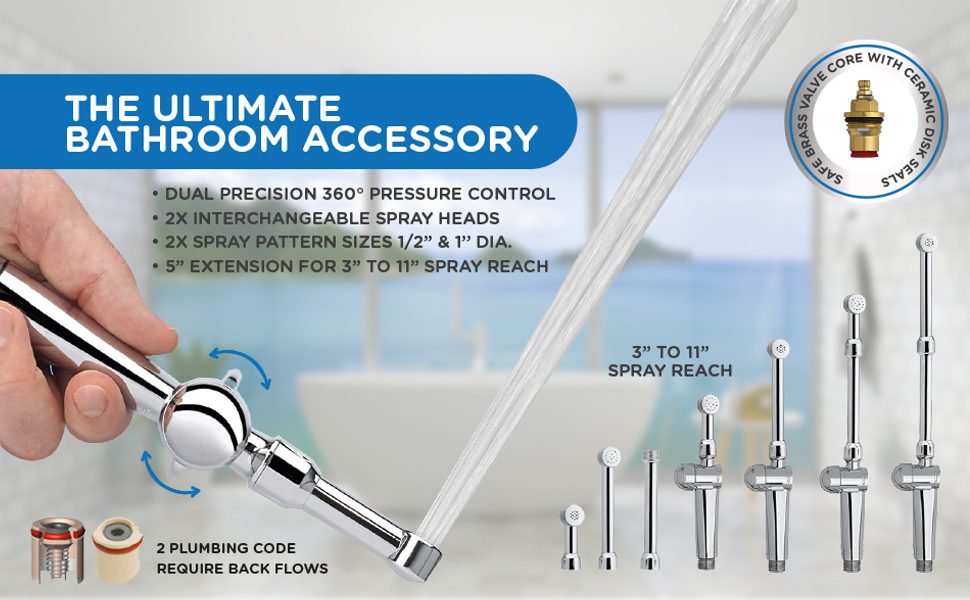
Compatibility with Existing Fixtures
Before purchasing a bidet converter kit, it’s important to ensure compatibility with your toilet and plumbing system. While most toilets in the USA and Canada feature standard 7/8″ fill valve threads, certain models may require additional accommodations, such as a flexible water supply line extension or wall valve adapter, especially if the fill valve is hidden behind the toilet side wall.
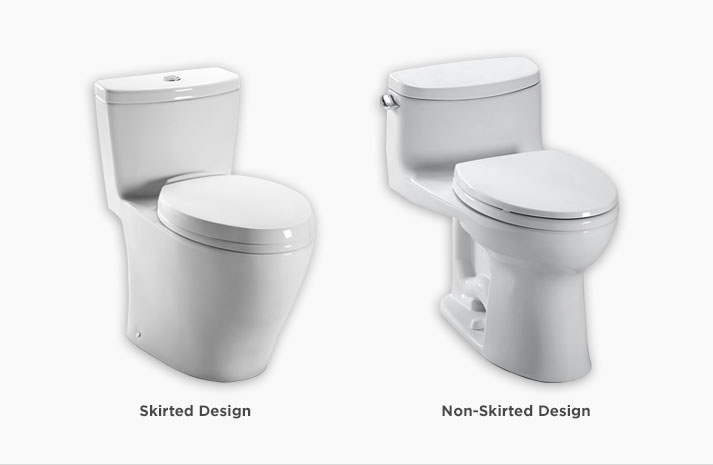
Water Pressure Control
Look for bidet converter kits that offer adjustable water pressure control. This feature allows you to customize the water flow to your desired comfort level, ensuring a pleasant experience every time.
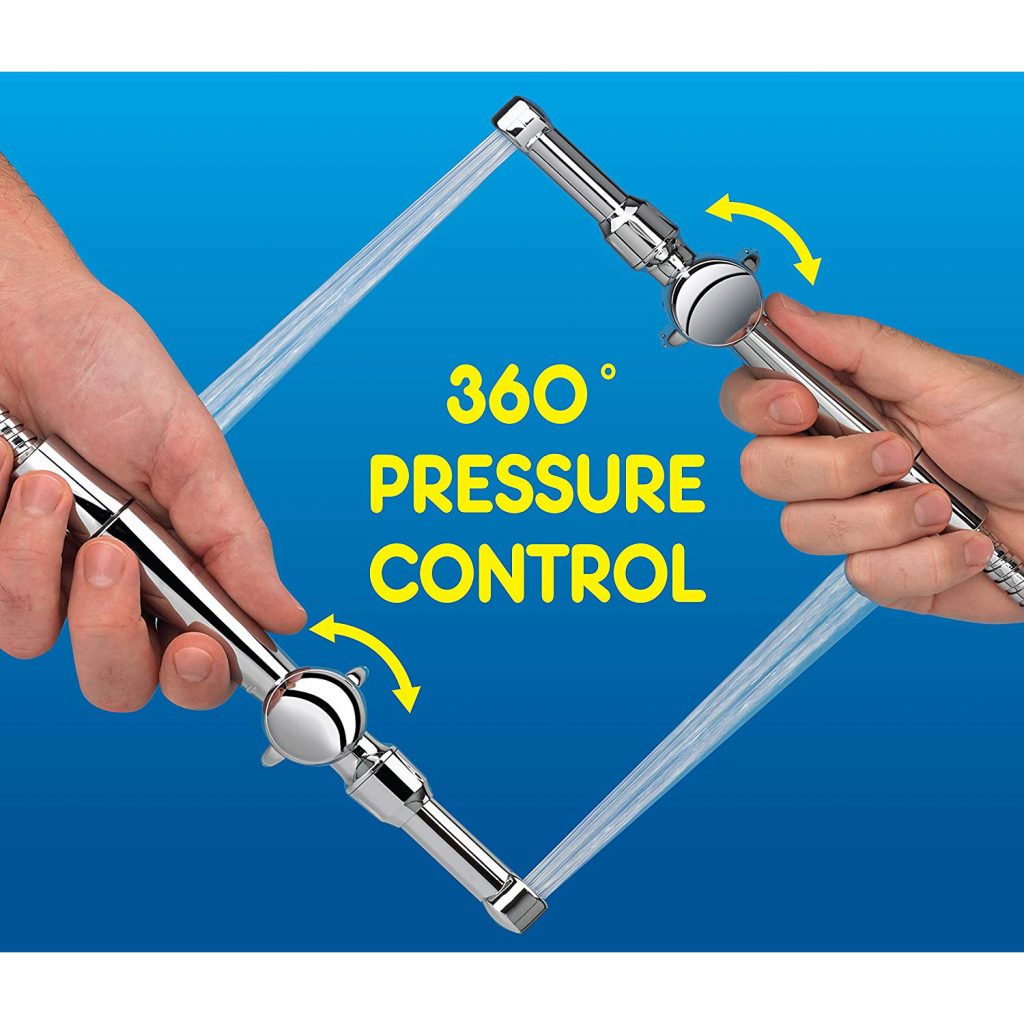
Durability and Maintenance
Consider the durability and ease of maintenance of the bidet converter kit. Look for materials that are resistant to rust and corrosion to ensure long-lasting use. Additionally, opt for models with an easy-to-clean design to simplify the maintenance process.
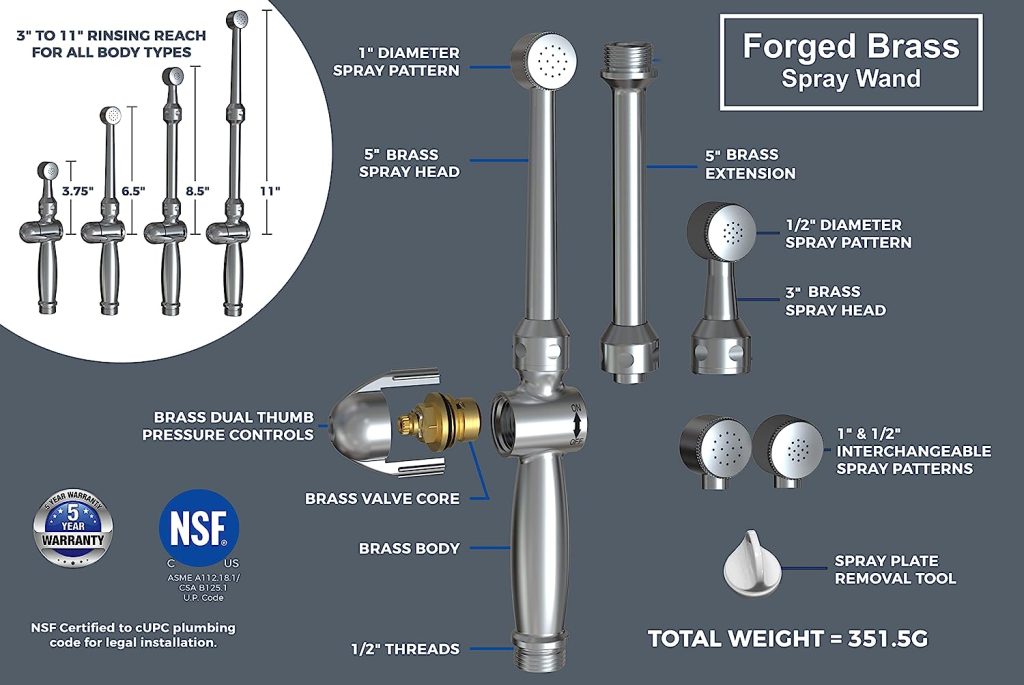
The Limitations of Kitchen Sink Sprayers for Personal Hygiene
When it comes to personal hygiene, using kitchen sink sprayers as a makeshift bidet falls short in several aspects. These sprayers are primarily designed for dishwashing purposes, not for rinsing under your front and back bottom areas while sitting on the toilet. The gun-shaped body of sink sprayers makes them awkward and uncomfortable to hold, often resulting in wet and messy hands during use because the spray button is located on the back and is too close to the spray head, so you have to insert your hand down in the toilet to rinse up, making it impossible to keep your hand clean and dry. Moreover, the spring valve design of sink sprayers is not intended to be fully pressurized, making them prone to leaking and reducing their lifespan. Forgetting to release pressure can lead to frequent leaks and potential damage.
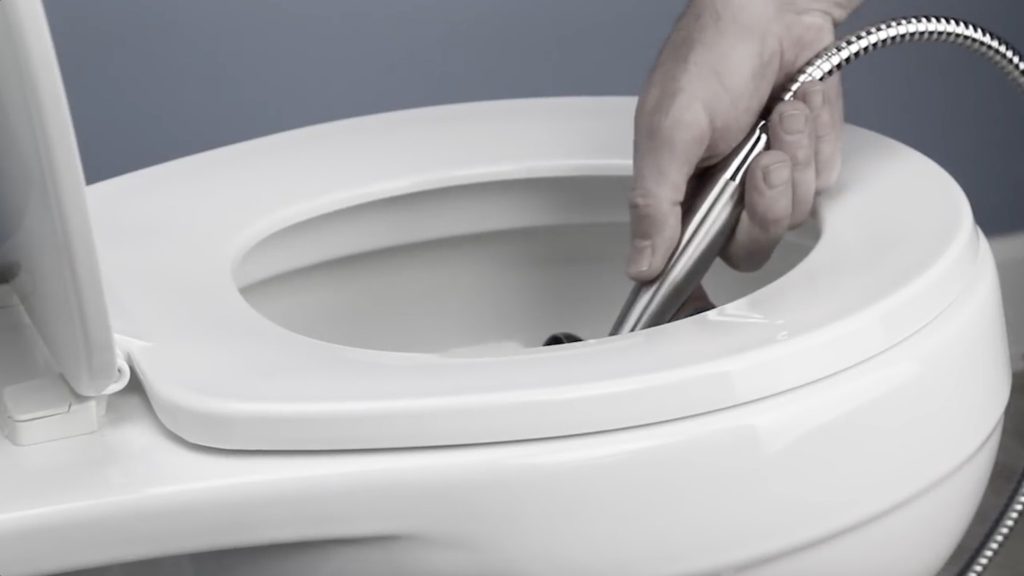


Kitchen sink sprayers have been a handy tool for many households when it comes to cleaning dishes and other kitchen-related tasks. However, when it comes to personal hygiene, especially rinsing under sensitive areas, such as the front and back bottoms while sitting on the toilet, these sprayers fall short. We will explore the limitations of kitchen sink sprayers for personal hygiene and discuss why they are not the most suitable option for such purposes.
Limitation 1: Inadequate Design for Personal Hygiene
One of the primary limitations of kitchen sink sprayers for personal hygiene is their design, which is primarily focused on cleaning dishes rather than rinsing specific body parts. The shape of these sprayers, often resembling a gun, makes them difficult, awkward, and uncomfortable to hold while trying to rinse oneself. The result is often messy hands and an overall uncomfortable experience.
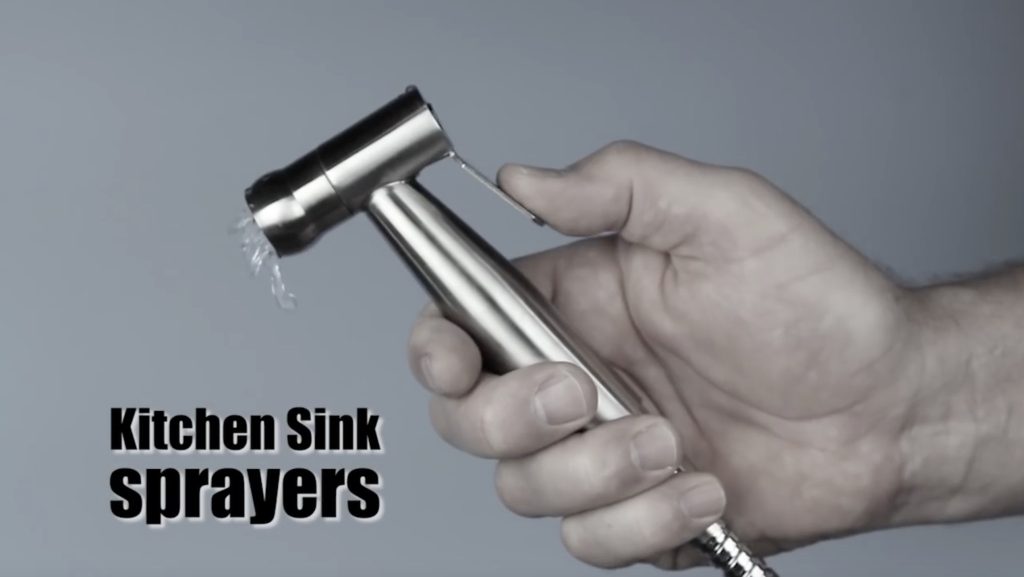
Limitation 2: Awkward and Uncomfortable Handling
Due to their design, holding kitchen sink sprayers without getting your hands wet and messy can be quite challenging. When using them for personal hygiene purposes, the gun-shaped body of the sprayer proves to be a hindrance. This limitation makes the process of rinsing oneself less efficient and enjoyable, ultimately compromising personal hygiene.
Limitation 3: Prone to Leakage and Short Lifespan
Kitchen sink sprayers are typically equipped with spring valves that are not designed to be fully pressurized. As a result, they are more prone to leakage and have a shorter lifespan, particularly if they are left under pressure for extended periods. Forgetting to release the pressure can lead to leaks, which not only waste water but also create additional maintenance and repair needs.
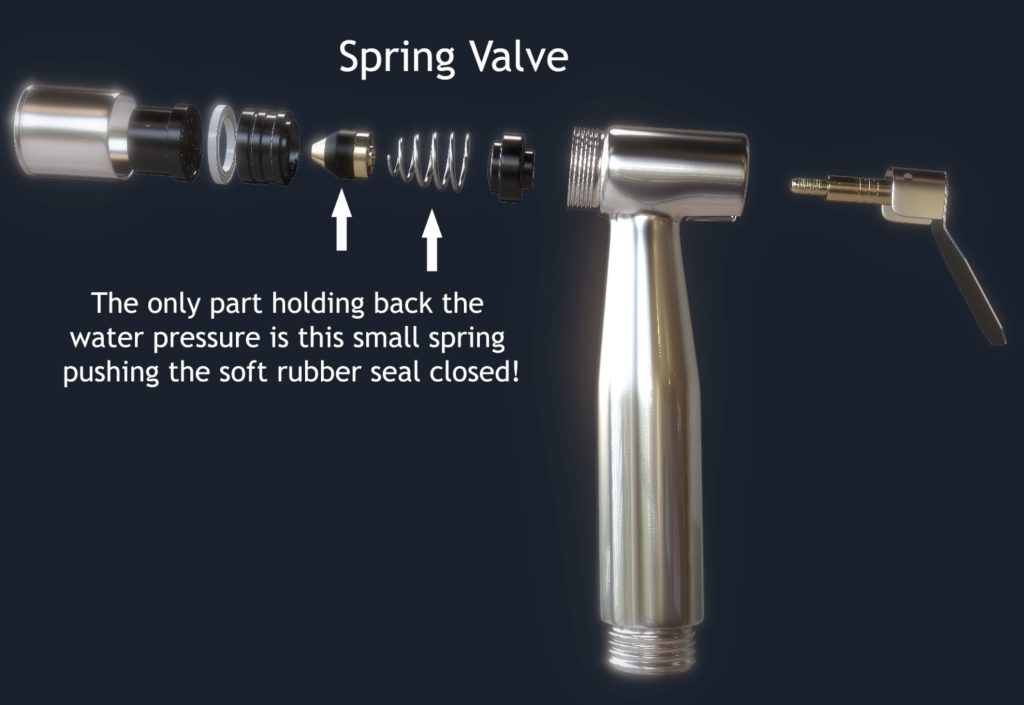
Limitation 4: Difficulty in Adjusting Spray Pressure
Precise rinsing requires the ability to adjust the spray pressure, which is often a challenge with kitchen sink sprayers. These sprayers lack user-friendly controls to fine-tune the water pressure, making it difficult to achieve the desired level of precision during personal hygiene routines. This limitation can be frustrating for individuals who seek a comfortable and efficient rinsing experience.
Limitation 5: Lack of Additional Features and Functionality
Unlike specialized bidet sprayers designed explicitly for personal hygiene, kitchen sink sprayers lack additional features and functionalities. They do not come with interchangeable spray heads or extensions for extended reach, which can be essential for comfortable and effective cleaning. Moreover, their construction using shower hoses with low-quality spring valves further limits their usability and flexibility.
A notable absence in kitchen sink sprayers is a vertical hose connection on the toilet adapter, which prevents stress and damage to the hose crimps. When the hose connects horizontally and bends down 90 degrees, it increases the likelihood of wear and tear over time. Furthermore, the lack of certified back-flow protectors hinders these sprayers from passing plumbing code testing by NSF, potentially compromising their safety and compliance.
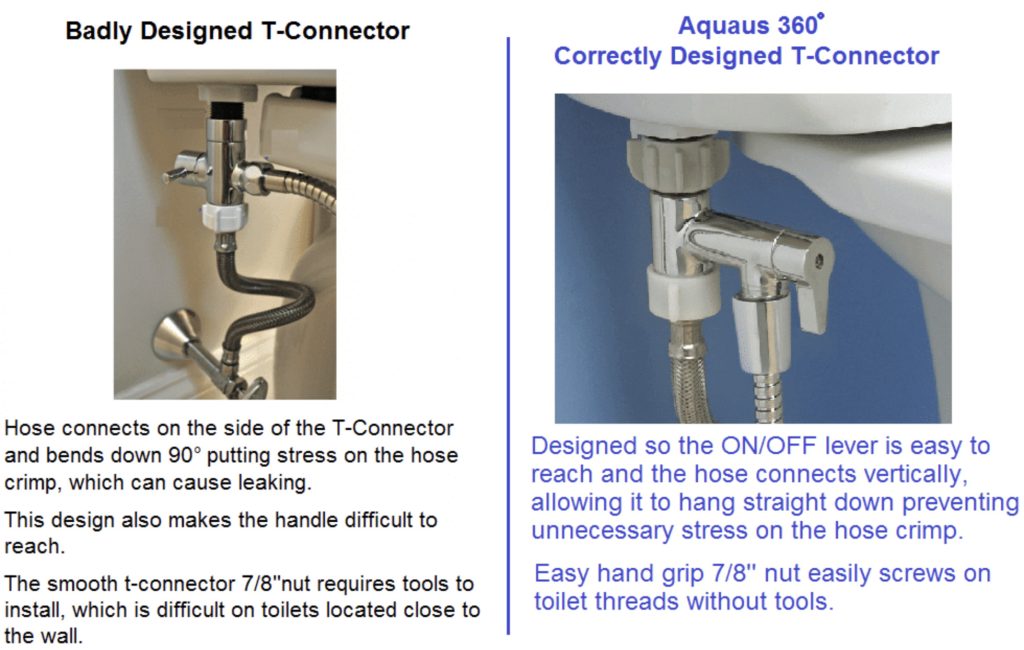
Conclusion
While kitchen sink sprayers are efficient tools for cleaning dishes, they have significant limitations when it comes to personal hygiene, especially rinsing under sensitive areas. Their inadequate design, uncomfortable handling, proneness to leakage, difficulty in adjusting spray pressure, and lack of additional features and functionality make them less suitable for this purpose. Individuals seeking an optimal personal hygiene experience should consider investing in a bidet sprayer that is specifically designed for personal hygiene.
The Drawbacks of Seat-Attached Bidets
Introduction
Seat-attached bidets have gained popularity as a convenient and hygienic alternative to traditional bathroom fixtures. However, they are not without their drawbacks. In this article, we will explore the limitations and drawbacks of seat-attached bidets. From restricted spraying direction to compatibility issues, it is essential to understand these drawbacks before making a decision about incorporating them into your bathroom routine.
Drawback 1: Limited Spraying Direction
One significant drawback of seat-attached bidets is that they only spray from the back. While this may be suitable for some users, it restricts the versatility of the bidet for other cleaning purposes. Unlike specialized bidet fixtures, seat-attached bidets cannot be used for cleaning other areas, such as the feet or the bathtub, limiting their functionality.
Drawback 2: Restricted Use for Cleaning Purposes
Due to their limited spraying direction, seat-attached bidets are not well-suited for comprehensive cleaning. This restriction can be particularly problematic for female users. Rinsing from the back to the front can increase the risk of urinary tract infections, as it introduces bacteria from the anal region to the urethra. Consequently, female users may find it challenging to achieve thorough and safe cleansing using seat-attached bidets.
Drawback 3: Challenges for Female Users
Female users face additional challenges when using seat-attached bidets. The limited spraying direction from the back does not adequately address their specific hygiene needs. Bidets that lack front-spray functionality can lead to potential health concerns, as rinsing from the back to the front can disrupt the natural balance of bacteria and increase the risk of infections.
Drawback 4: Cleaning Hassles
Maintaining cleanliness in the bathroom is crucial, and seat-attached bidets can pose challenges in this regard. To clean under the bidet attachment, the toilet seat must be removed, adding an extra step to the cleaning routine. This inconvenience can become bothersome over time and may deter users from properly maintaining their bidet attachment, potentially compromising hygiene standards.
Drawback 5: Potential Malfunctions and Failures
Seat-attached bidets consist of multiple parts, increasing the likelihood of malfunctions and failures. The complexity of the attachments can result in issues such as leaks, faulty controls, or clogged nozzles. These problems not only affect the functionality of the bidet but also require additional maintenance or replacement parts, leading to increased costs and inconveniences.
Drawback 6: Electrical Requirements
Certain seat-attached bidet models require an electrical plug located behind the toilet for operation. This electrical requirement can be problematic in bathrooms that lack an easily accessible electrical outlet in close proximity to the toilet. Users may need to hire an electrician to install a new outlet, adding to the overall cost and complexity of incorporating the bidet into their bathroom.
Drawback 7: Lack of Safety Shut-Off Valve
Unlike some standalone bidet models, seat-attached bidets often lack a safety shut-off valve. This valve serves as a failsafe mechanism to prevent accidental spraying when the bidet is not in use. The absence of this feature can lead to water wastage and potential discomfort for users if the bidet activates unintentionally.
Drawback 8: Compatibility Issues
Seat-attached bidets are designed to fit specific toilet seat shapes and sizes. This can pose compatibility issues if your toilet seat doesn’t match the bidet attachment. Users may need to conduct additional research to find a compatible bidet attachment or even consider replacing their current toilet seat altogether. This added complexity and potential expense can deter individuals from incorporating seat-attached bidets into their bathrooms.
Conclusion
While seat-attached bidets offer convenience and hygiene benefits, they also come with significant drawbacks. The limitations of restricted spraying direction, challenges for female users, cleaning hassles, potential malfunctions, electrical requirements, lack of safety shut-off valves, and compatibility issues should be carefully considered. It is essential to weigh these drawbacks against the advantages before deciding to invest in a seat-attached bidet.
The Aquaus 360° Spray Wand: Revolutionizing Personal Hygiene
The Aquaus 360 Bidet Converter Kit is revolutionizing personal hygiene by offering a superior alternative to traditional bathroom routines. Designed with precision and comfort in mind, this handheld bidet outperforms other options such as kitchen sink sprayers and seat-attached bidets. With its unique features, durability, and legal installation approval, the Aquaus 360 ensures a refreshing and efficient bathroom experience. In this article, we will explore the limitations of other hand bidet options, highlight the exceptional features of the Aquaus 360, compare it to alternative bidet systems, and explain why it is the optimal choice for your bathroom.

Ergonomic Design and Precision Rinsing:
The Aquaus 360° Spray Wand features a unique, ergonomic design that ensures comfort and precision during use. With this bidet sprayer, you can rinse under your front and back bottom areas while comfortably sitting on the toilet, without getting your hand wet or messy.
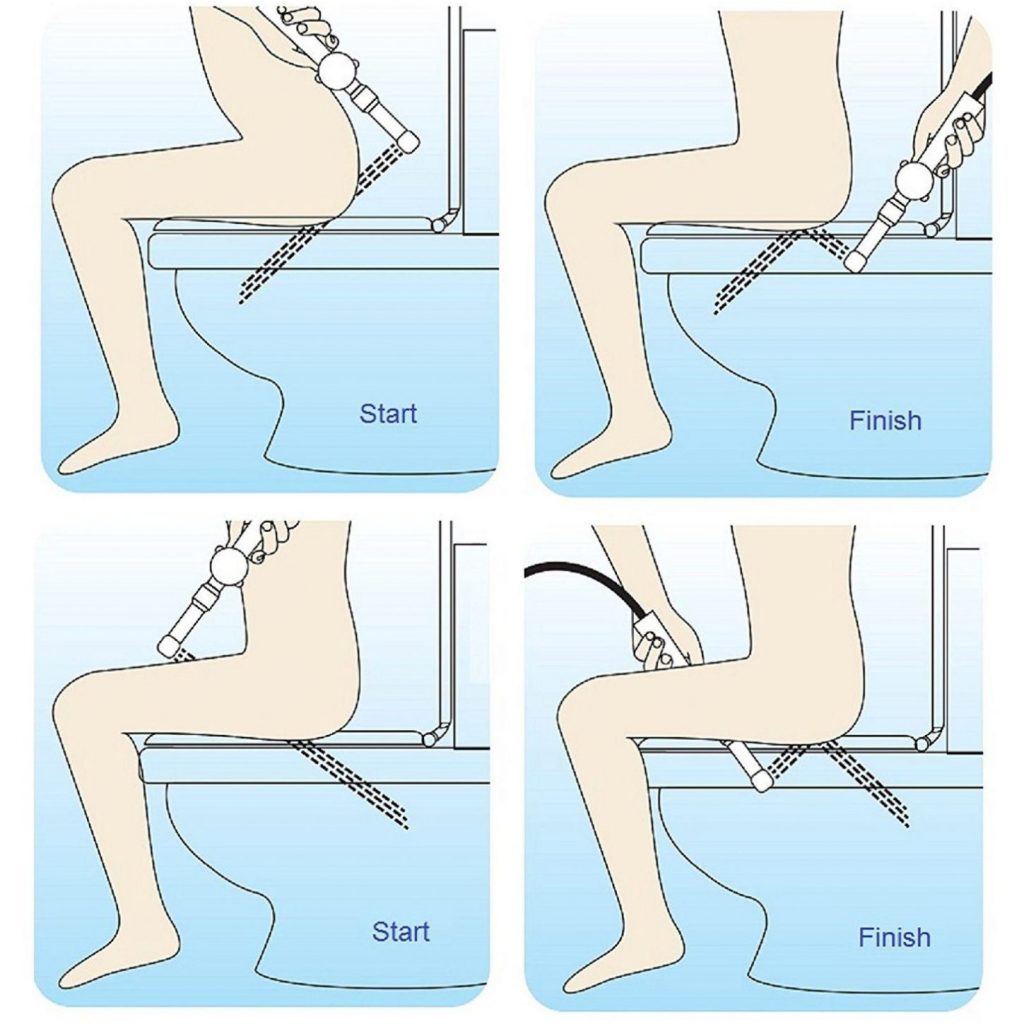
High-Quality Brass Valve Core with Ceramic Disc Seals:
Unlike other hand bidet options, the Aquaus 360 is designed with a durable brass valve core that incorporates ceramic disc seals, similar to those used in kitchen and bathroom faucets. This design guarantees safe and reliable use in your home, with a valve core lifespan of over 10 years. In the event of wear and tear, the valve core can be easily replaced, eliminating the need to purchase a new sprayer.

Longevity and Cost-Effectiveness:
The Aquaus 360 ensures a low risk of leaks, even when left under pressure, thanks to its high-quality construction. Unlike other options with short lifespans, this bidet converter kit is built to last, offering long-term cost savings. With the Aquaus 360, you can trust in its durability and avoid frequent replacements.
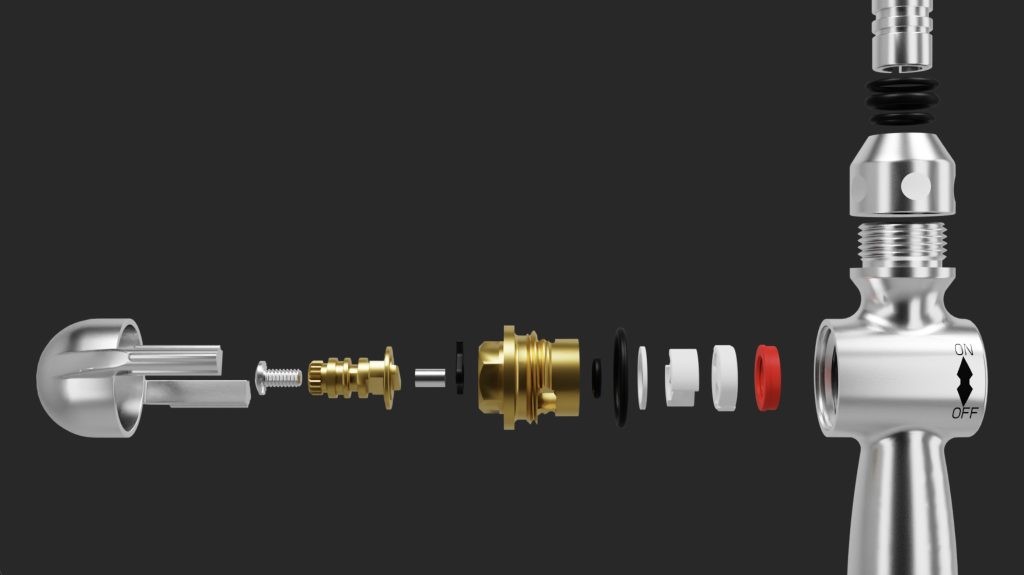
Safety and Compliance with Plumbing Codes:
Safety is paramount when it comes to bathroom installations. The Aquaus 360 is the only handheld bidet sprayer that has been NSF tested and approved for legal installation in the USA and Canada. It includes two plumbing code-required back-flow protectors, ensuring that the drinking water supply remains uncontaminated in the event of a back-flow event.
Dual Thumb Pressure Controls for Enhanced Comfort:
The Aquaus 360 features dual thumb pressure controls, allowing you to comfortably hold and control the spray pressure from both sides. This design ensures an ergonomic grip and effortless adjustment of the water pressure to suit your preferences.
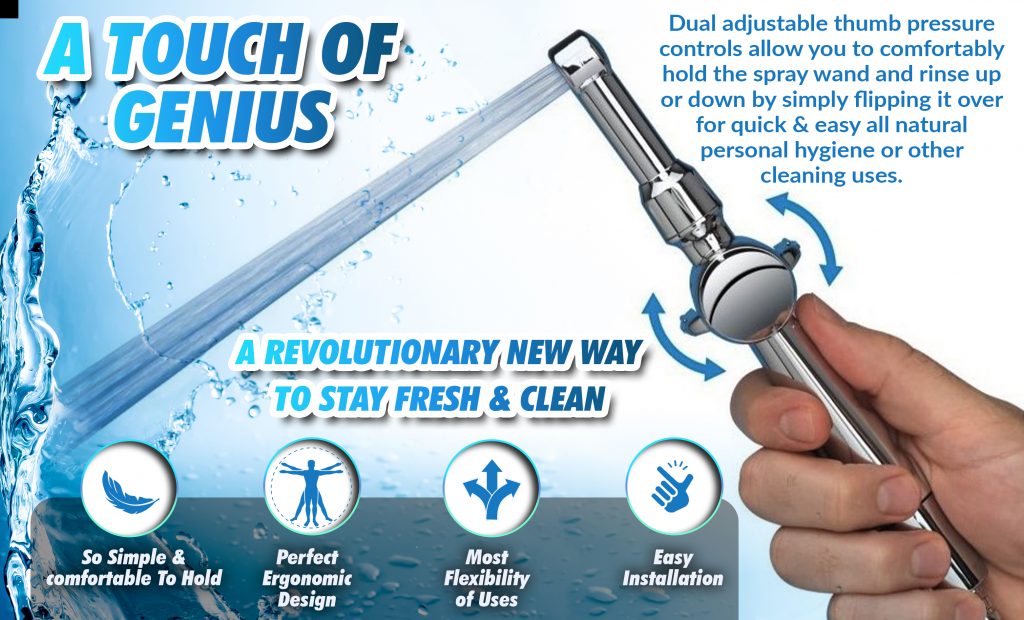
Versatile Spray Reach and Patterns:
With the Aquaus 360, you can easily rinse up and down by simply flipping the sprayer over. It offers three interchangeable spray heads and a 5-inch extension, providing a spray reach of 3 to 11 inches to accommodate users of all body sizes. Additionally, the bidet converter kit offers ½-inch and 1-inch spray pattern options, allowing you to customize your cleaning experience.

Manufactured in the USA with Domestic and Global Components:
The Aquaus 360 is proudly made in the USA, incorporating both domestic and global components. This ensures high-quality manufacturing standards and supports local and international businesses.
Patented Design and International Recognition:
The Aquaus 360 boasts a patented design in the USA, with international patents pending. Its innovative features have earned recognition globally, solidifying its position as a leader in the bidet industry.
Aquaus 360 Handheld Bidet vs. Kitchen Sink Sprayer Bidets vs. Seat-Attached Bidets
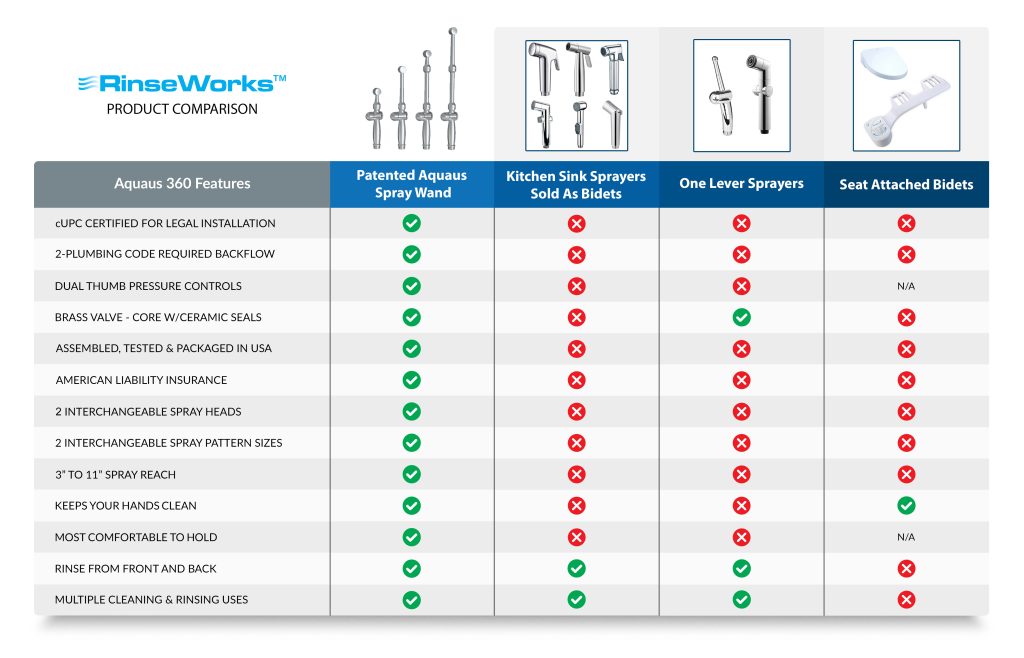
Features and Functionality:
When comparing the Aquaus 360 Handheld Bidet with kitchen sink sprayer bidets and seat-attached bidets, it stands out for its unique features and enhanced functionality. While kitchen sink sprayers are not designed for personal hygiene, seat-attached bidets have limited spraying capabilities and are not versatile for other cleaning uses. The Aquaus 360, on the other hand, provides precision rinsing and can be used for a variety of cleaning purposes.
Ease of Use and Comfort:
The ergonomic design of the Aquaus 360 ensures comfortable and effortless use, allowing you to maintain hygiene without discomfort or inconvenience. In contrast, kitchen sink sprayers are challenging to hold without getting your hand wet and messy, while seat-attached bidets may lack convenience for female users due to their back-only spraying mechanism.
Reliability and Durability:
The Aquaus 360’s brass valve core with ceramic disc seals guarantees reliability and durability, offering a lifespan of over 10 years. Kitchen sink sprayers with spring valves are prone to leaks and have a shorter life span, especially if left under pressure. Seat-attached bidets often consist of multiple parts that can malfunction over time.
Legal Installation Approval:
The Aquaus 360 is the only handheld bidet sprayer that has been tested and approved for legal installation according to plumbing codes in the USA and Canada. Kitchen sink sprayers and seat-attached bidets may not have the same level of approval, potentially causing issues with compliance.
Flexibility of Uses:
Unlike kitchen sink sprayers, the Aquaus 360 offers versatility in its applications. It can be used for personal hygiene, cleaning diapers, pet care, and more. Seat-attached bidets, on the other hand, are limited to back-only spraying, making them less versatile.
Quality and Longevity:
The Aquaus 360’s high-quality construction and replaceable valve core ensure long-lasting performance, offering a cost-effective solution over time. Kitchen sink sprayers and seat-attached bidets may require frequent replacements due to their inferior design and shorter lifespan.
Why Choose the Aquaus 360 Bidet Converter Kit?
Superior Design and Functionality:
The Aquaus 360 Bidet Converter Kit surpasses other bidet options in terms of design and functionality. Its ergonomic design, precision rinsing capabilities, and ease of use set it apart from kitchen sink sprayers and seat-attached bidets.
Refreshing and Efficient Bathroom Experience:
Experience a truly refreshing and efficient bathroom routine with the Aquaus 360. Its ability to rinse under your front and back bottom areas while sitting on the toilet ensures thorough cleanliness and a fresh feeling.
Versatile Applications and Precision Rinsing:
The Aquaus 360’s versatility allows for various applications, from personal hygiene to cleaning tasks. Its precision rinsing capabilities ensure effective and targeted cleaning, providing optimal hygiene and comfort.
Durable and Replaceable Valve Core:
With its brass valve core and ceramic disc seals, the Aquaus 360 guarantees durability and longevity. If the valve core ever needs replacement, it can be easily done without the need to purchase a new sprayer, saving you money in the long run.
Compliance with Plumbing Codes and Safety Standards:
The Aquaus 360 has undergone rigorous testing and is NSF approved for legal installation in the USA and Canada. With the inclusion of plumbing code-required back-flow protectors, you can rest assured that the bidet converter kit meets safety standards and protects your drinking water supply.
Cost-Effective and Environmentally Friendly:
Investing in the Aquaus 360 Bidet Converter Kit is a cost-effective choice. Its long lifespan, durability, and replaceable parts eliminate the need for frequent replacements. Moreover, by reducing the use of toilet paper, the Aquaus 360 promotes environmental sustainability.
Frequently Asked Questions (FAQs)
How does a bidet converter kit work? A bidet converter kit connects to the existing water supply of your toilet. When activated, the sprayer or nozzle releases a controlled stream of water for cleansing purposes. The water pressure and temperature can be adjusted according to personal preference.
Can a bidet converter kit be installed in any bathroom?
Most bidet converter kits are designed to be compatible with standard toilets and plumbing systems. However, it is advisable to check the specifications and compatibility information provided by the manufacturer before making a purchase.
Are bidet converter kits easy to clean?
Bidet converter kits are generally easy to clean. Many models feature self-cleaning nozzles that help maintain hygiene. Additionally, most components can be easily detached for cleaning purposes.
What is the average cost of a bidet converter kit?
The cost of bidet converter kits can vary depending on the brand, features, and quality. On average, a bidet converter kit can range from $30 to $150. It’s important to consider factors like durability, functionality, and warranty when evaluating the price.
Can bidet converter kits be used for hot water washing?
Some bidet converter kits offer options for both cold and hot water washing. However, this depends on the specific model and its compatibility with hot water connections. It’s recommended to check the product specifications or consult the manufacturer to confirm hot water compatibility.
Conclusion
Bidet converter kits provide a convenient and affordable way to upgrade your bathroom experience. With benefits ranging from improved hygiene and cost-effectiveness to eco-friendliness and enhanced comfort, these kits have become increasingly popular. By considering factors such as installation method, adjustable features, compatibility, water pressure control, and durability, you can choose the perfect bidet converter kit that suits your preferences and needs. Say goodbye to traditional toilet paper and embrace the modern convenience and cleanliness offered by a bidet converter kit in your bathroom.


